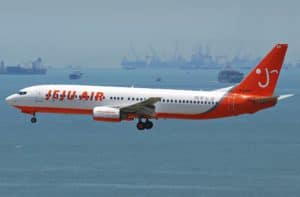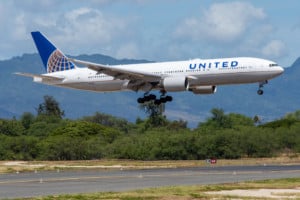If you’ve ever flown on a commercial airliner, there’s a good chance it was either a Boeing 737 or a Boeing 777. These two plane models are by far the most popular in the world, and for a good reason. Let’s compare the Boeing 737 and 777 and find the winner.
| Aircraft: | Boeing 737-800 | Boeing 777-200ER |
|---|---|---|
| Photo: |
 |
 |
| Country: | United States | United States |
| Manufactured: | from: 1998 to: Present | from: 1996 to: Present |
| ICAO: | B738 | B772 |
| Price: | $89.2 million | $306.6 million |
| Avionics: | Rockwell Collins avionics | Honeywell Avionics |
| Engine: | 2x Snecma / CFM56-7B27 | 2x Pratt and Whitney PW 4090 or Rolls-Royce Trent 895 or GE GE90-94B |
| Engine Type: | Turbofan | Turbofan |
| Power: | 27,300 pound-force | 93,700 pound-force |
| Max Cruise Speed: |
473 knots 876 Km/h |
510 knots 945 Km/h |
| Approach Speed (Vref): | - | 136 knots |
| Travel Range: |
3,060 Nautical Miles
5,667 Kilometers |
7,510 Nautical Miles
13,909 Kilometers |
| Fuel Economy: |
0.44 nautical mile / gallon 0.215 kilometres / litre |
0.17 nautical mile / gallon 0.083 kilometres / litre |
| Service Ceiling: | 41,000 feet | 43,100 feet |
| Rate of Climb: | - |
3000 feet / minute 15.24metre / second |
| Take Off Distance: |
2316 metre 7,598.33 feet |
2438 metre 7,998.59 feet |
| Landing Distance: |
1372 metre 4,501.26 feet |
1554 metre 5,098.36 feet |
| Max Take Off Weight: |
384,039 Kg 846,652 lbs |
297,550 Kg 655,979 lbs |
| Max Landing Weight: | - |
213,180 Kg 469,977 lbs |
| Max Payload: |
21,319 Kg 47,000 lbs |
59,422 Kg 131,002 lbs |
| Fuel Tank Capacity: |
6,875 gallon 26,025 litre |
45,220 gallon 171,176 litre |
| Baggage Volume: |
45.1 m3 1,593 ft3 |
162 m3 5,721 ft3 |
| Seats - Economy: | 189 seats | 440 seats |
| Seats - Business Class: | 175 seats | 400 seats |
| Seats - First Class: | 162 seats | 301 seats |
| Cabin Height: |
2.2 metre 7.22 feet |
2.2 metre 7.22 feet |
| Cabin Width: |
3.54 metre 11.61 feet |
5.86 metre 19.23 feet |
| Cabin Length: |
29.97 metre 98.33 feet |
49.1 metre 161.09 feet |
| Exterior Length: |
39.5 metre 129.59 feet |
63.7 metre 208.99 feet |
| Tail Height: | - | 18.5 metre - 60.69 feet |
| Fuselage Diameter: |
3.76 metre 12.34 feet |
6.19 metre 20.31 feet |
| Wing Span / Rotor Diameter: |
34.31 metre 112.56 feet |
60.9 metre 199.80 feet |
| Wing Tips: | No Winglets | No Winglets |
| More Info: | Boeing 737-800 | Boeing 777-200ER |
|
Data presented is for entertainment purposes and should not be used operationally.
|
Other Boeing 737-800 comparisons:
- Boeing 737-800 vs 757-300
- Boeing 747-8 vs 737-800
- Boeing 787-8 vs 737-800
- Airbus A380-800 vs Boeing 737-800
Other Boeing 777-200ER comparisons:
About the Boeing 737
The Boeing 737 is a short-to-medium-range plane. Its roots date back to 1967 when the first Boeing 737 took flight. The main difference between the Boeing 737 models is their size; early models could only seat around 100 passengers, while later ones could seat close to 200.
Why was it developed and built?
Boeing developed the Boeing 737 to meet the market demand for a short- to the medium-range plane that could comfortably carry passengers. The aircraft was designed to be a versatile, efficient, and cost-effective way for airlines to move people.
What purpose does it serve?
The Boeing 737 is used for various passenger and freight transport applications. Airlines use the aircraft to shuttle passengers over short distances and to serve as a regional jet. Military and private charter companies also use it for special missions.
About the Boeing 777
The Boeing 777 is a long-range aircraft that was introduced in 1995. It can seat between 300 and 550 passengers, depending on the configuration. And the wide-body plane means that it has two aisles running the length of the cabin.
Why was it developed and built?
Boeing developed it as a larger and more efficient version of its Boeing 767. The plane was designed to be an ultra-long-haul aircraft that could fly non-stop from one side of the world to the other.
What purpose does it serve?
The Boeing 777 is a popular choice for airlines looking to fly long distances. The range, capacity, and comfort make it an ideal option for international routes. Airlines also use the Boeing 777 for cargo flights and private charter services.
How are the Boeing 737 and Boeing 777 different?
They’re both incredibly efficient and have proven themselves time and time again to be reliable workhorses of the skies. But what, exactly, sets them apart? Let’s take a closer look.
Size
One of the most noticeable differences between the Boeing 737 and the Boeing 777 is size. The Boeing 737 is a narrow-body aircraft, while the Boeing 777 is a wide-body aircraft.
This difference in size can be attributed to the different roles each aircraft was designed to fill. The Boeing 737 was designed for shorter flights with fewer passengers, while the Boeing 777 was designed for longer flights with more passengers.
Engines
Another difference between these two aircraft is the engines. The Boeing 737 has two engines, while the Boeing 777 has 2 or 4 engines. The aircraft engines are dictated by factors like the aircraft’s size and weight and the range it needs to fly.
Range
Speaking of range, the Boeing 737 has a shorter range than the Boeing 777. This, again, is due to the differences in size between the two aircraft. The Boeing 737 was not designed to stay in the air as long as the Boeing 777.
Wingspan
The wingspan of an airplane dictates how much runway it needs to take off and land safely.
Not surprisingly, given its larger size, the Boeing 777 has a longer wingspan than the Boeing 737. The wingspan of a Boeing 737 is 35 meters, while the Boeing 777 can be anywhere from 60 to 64 meters.
Passenger Capacity
Finally, there is a difference in passenger capacity between these two aircraft types. The Boeing 737 can seat anywhere from 110 to 215 passengers, while the Boeing 777 can anywhere from 314 to 396.
Overall, it is clear that the Boeing 737 and Boeing 777 are two very different aircraft. While they both serve the same purpose of transporting passengers and cargo, they are designed to cater to different types of transportation needs.
How are the Boeing 747 and Boeing 777 similar?
The Boeing 747 and Boeing 777 are two of the most well-known and longest-serving models in commercial airplanes.
Both planes are wide-body jets that can accommodate many passengers and cargo and have been in production for over 40 years. Here’s a closer look at some similarities between these two iconic aircraft.
- Both are twin-engine planes. The 747 has four engines, while the 777 has two. However, both engines are powerful enough to allow the plane to take off and land safely, even if one engine fails.
- Both planes also have a similar flight deck layout. The pilot and copilot sit side-by-side in the 747, while in the 777, they’re separated by a console.
- Both cockpits have instrument panels that show essential data about the plane’s speed, altitude, and heading. There are also controls for operating the plane’s systems, such as its hydraulic brakes and landing gear.
What’s better about the Boeing 747?
The Boeing 747 is truly a marvel of engineering. Here are just a few of the many reasons why the Boeing 747 is such a great aircraft.
- To start with, the Boeing 747 has a massive wingspan. This gives the airplane plenty of lift, which is essential for taking off and landing.
- The airplane can carry over 500,000 pounds of cargo, which is more than enough to transport everything from cars to livestock. It has even been used to transport large machineries, such as bulldozers and excavators.
- Finally, the Boeing 747 is designed for long-haul flights. The airplane is outfitted with comfortable seating and amenities, making it ideal for traveling in style.
What’s better about the Boeing 777?
The Boeing 777 is an incredibly versatile and reliable aircraft. Here are some unique features that make it better:
- First, the Boeing 777 is incredibly fuel-efficient. Its engines are specially designed to burn less fuel than other planes, meaning your flights will cost you less.
- Second, the plane’s wingspan is smaller than the Boeing 747, but its aerodynamic design still allows it to generate plenty of lift. This makes the plane easier to maneuver and better to take off and land at shorter runways.
- Finally, the Boeing 777 has a larger cargo capacity than the Boeing 747. This makes it ideal for transporting large or bulky items, such as industrial equipment or furniture.
Overall, the Boeing 777 is an incredibly reliable and versatile aircraft.
Conclusion
So there you have it—a quick rundown of some key differences between Boeing’s two most popular plane models.
Whether you’re a seasoned traveler or just someone curious about how these massive machines work, we hope this article helped shed some light on some of the things that set them apart.


